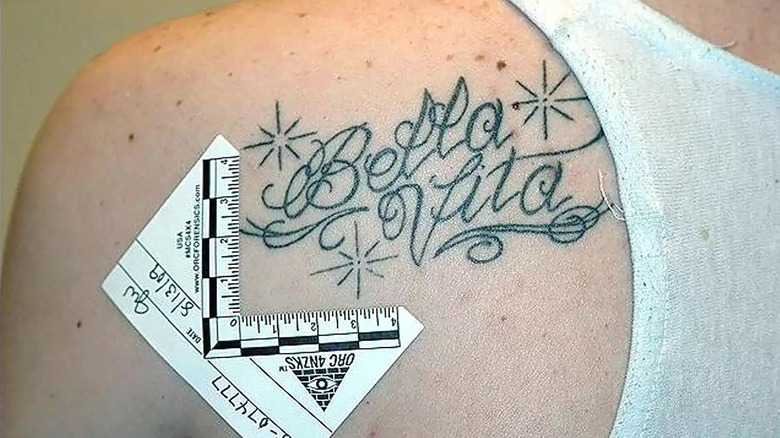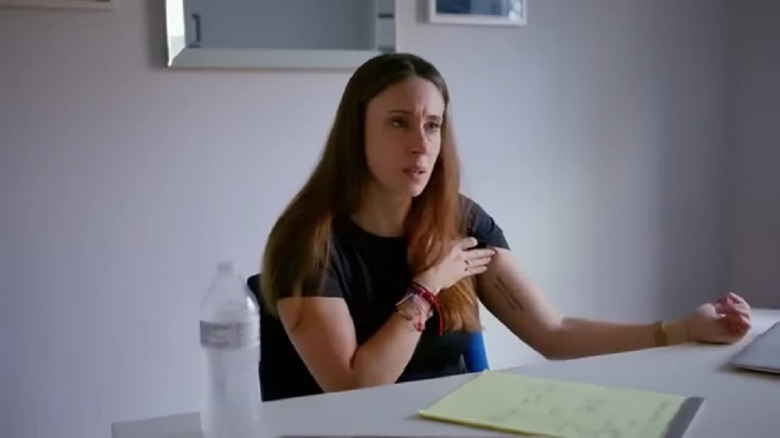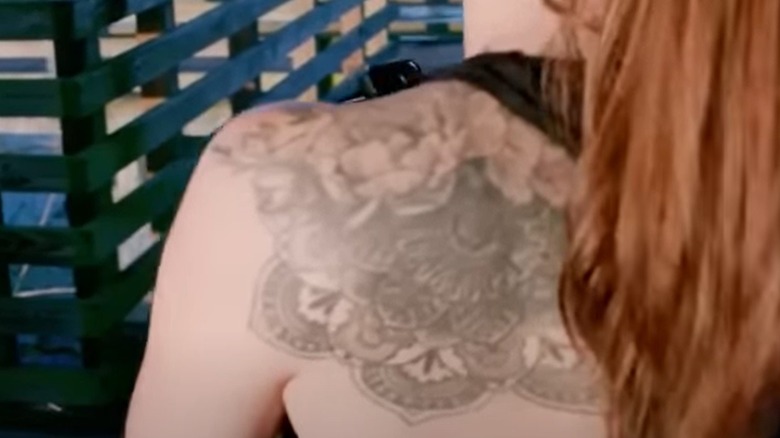The Meaning Behind Casey Anthony's Three Tattoos
Casey Anthony was involved in a controversial case that involved the death of her daughter, 2-year-old Caley. In July 2008, Casey's mother, Cindy, reported to the police that her grandchild had been missing for a month. Casey was charged with first-degree murder, manslaughter, aggravated child abuse, and providing false information to the authorities, but she insisted that she had nothing to do with her daughter's disappearance (via CNN). In December of that year, Caley's skeletal remains were discovered in a wooded area in close proximity to where the Anthonys lived.
Casey's trial began in May 2011 and lasted for six weeks. The prosecution alleged that the young mother's motive for killing her daughter was to get rid of her responsibilities as a parent. At the end of the trial, the jury — which consisted of five men and seven women — deliberated for more than 10 hours before returning a not-guilty verdict on the first-degree murder and child abuse charges, as reported by the Crime Museum. However, she was found guilty of providing false information to the authorities. One of the controversies during the trial was the tattoo Casey got shortly before her daughter was reported missing.
Bella Vita tattoo
On July 2, 2008, Casey Anthony visited a tattoo parlor to get a new tattoo done. At that time, her daughter had been missing for about a couple of weeks, but it had not been reported. The tattoo read "Bella Vita," which translates to "beautiful life" in Italian, and it was entered as evidence during Anthony's trial. The tattoo artist, Bobby Williams, testified in court, per CBS News. He said that Anthony called to make an appointment two days prior, and when she went to the shop, she had a happy disposition and didn't think that anything was wrong.
Williams further stated that Anthony told him that her daughter was with her nanny and that she would be bringing her the next time she visited the tattoo shop. The prosecution claimed that Anthony's party lifestyle and the tattoo she got while her daughter was missing were indicative that she had no concern for her daughter and that she was living a "beautiful life" without having to worry about parental responsibilities. In the Peacock documentary series "Casey Anthony: Where the Truth Lies," she explained that she got the tattoo as a "f*** you" to her family. "It was the antithesis of what my life really was," she stated.
Caylee tribute tattoo
Many still believe that Casey Anthony was responsible for her daughter's death despite her not-guilty verdict. According to her friends, Casey was always with Caley whenever they met up with her, and it seemed that she had been a great mother. However, they were shocked about her behavior after Caley disappeared (via Parade). In the Peacock documentary, Casey spoke out about her daughter's death and blamed her father, George. She also alleged that George sexually abused her.
During the trial, Casey's defense team claimed that Caley drowned in a pool, and in the documentary, she blamed her father for purportedly orchestrating the drowning to cover up abuse. People noted that George had never been charged in regard to Casey's claim, and he has also denied her allegations. Casey showed framed sonogram photos of Caley in the documentary and also revealed a tattoo on her inner arm that reads, "I hear your voice and all the sounds of the world," which she explained she got in honor of her daughter, as she said she hears her "in everything."
The cover-up tattoo
Casey Anthony had her "Bella Vita" tattoo covered, as it reminded her of a difficult time in her life. An unnamed source close to her told People that she had wanted to do that for a long time, but was undecided about the design until 2018. The source said that covering the tattoo was symbolic of Anthony moving forward with her life. The new tattoo was shown in the Peacock documentary, and when asked what it was, Anthony said the design consisted of peonies and half of a mandala, which she explained were symbols of rebirth and growth.
According to Florgeous, the word peony is derived from the Greek word "paonia," and the flowers were once used as medicine for their healing properties. Mandalas, on the other hand, are symbols often used in sacred ceremonies and meditation in Asian culture, and when it comes to tattoos, the elements included in the mandala may symbolize different things for the person, but often illustrates creation or rebirth.



